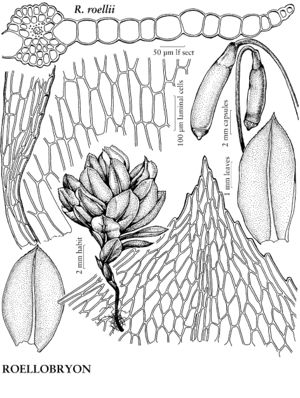Difference between revisions of "Roellobryaceae"
imported>Volume Importer |
imported>Volume Importer |
||
| Line 40: | Line 40: | ||
|publication year= | |publication year= | ||
|special status= | |special status= | ||
| − | |source xml=https:// | + | |source xml=https://bitbucket.org/aafc-mbb/fna-data-curation/src/2e0870ddd59836b60bcf96646a41e87ea5a5943a/coarse_grained_fna_xml/V28/V28_298.xml |
}}<!-- | }}<!-- | ||
-->[[Category:Treatment]] | -->[[Category:Treatment]] | ||
Latest revision as of 21:35, 5 November 2020
Plants acrocarpous. Stems rosulate, unbranched, stolons absent; rhizoids few, confined to stem base, micronemata and macronemata absent. Leaves broadly ovate to obovate, finely rugose, large; base ± straight at insertion, decurrent; margins revolute proximally, plane distally, serrate distally, rarely nearly entire, 1-stratose, limbidium present, well developed; apex acute, sometimes mucronate; costa slender, green-yellow, percurrent, stereid band reduced or stereids nearly absent, basal adaxial supracostal cells long-rectangular; alar cells similar to juxtacostal cells; laminal cells large, obscurely heterogeneous; proximal cells long-rectangular, longer than distal cells; medial and distal cells usually hexagonal to rhomboidal, not oblique to costa, walls thin, not distinctly pitted. Specialized asexual reproduction absent. Sexual condition dioicous; perigonia and perichaetia terminal; perigonia enlarged, forming rosette, inner leaves highly differentiated, often narrower and costa weaker. Seta single or sometimes double. Capsule nutant, long-exserted, long-pyriform to elongate-cylindric, sometimes curved; hypophysis well differentiated; annulus revoluble; operculum convex, short-conic; peristome diplolepidous-alternate; exostome teeth lanceolate-acuminate, narrowly bordered, trabeculate, papillose, pores absent; endostome free, pale, basal membrane high, segments keeled, perforate, cilia (2–)3–4, long, nodose. Calyptra fugacious, cucullate, small, smooth. Spores shed singly.
Distribution
w North America.
Discussion
Species 1.
Plants of Roellobryon are large, distinctive mosses found in high-elevation and cool-climate forests of western North America, typically on litter in dense shade. The taxonomic placement of R. roellii has long been debated; early workers placed the species in either Bryum or Mnium, while more recently it has been segregated as a monotypic genus and placed in Bryaceae, primarily because of its distinctive laminal areolation. Although Roellobryon is morphologically similar to Rhodobryum and Rosulabryum, recent molecular studies suggest that it is closer to Mniaceae than Bryaceae. Superficially, under the light microscope, the species looks distinctly mniaceous; it is best placed in its own family. Recently, R. Ochyra (2011) pointed out that the previously used genus name, Roellia Kindberg, is an orthographic variant of Roella Linnaeus, a genus in the Campanulaceae, and the name Roellobryon replaces Kindberg’s name. Roellobryon is similar to species of Rhodobryum of the flora, but differs in the much larger laminal cells and leaves that are rugose and shrunken but not strongly contorted and twisted when dry.
Selected References
None.
Lower Taxa
Illustrations
| Family ⠉ | Taxon | Illustrator ⠉ | |
|---|---|---|---|
 | Roellobryaceae | Roellobryon roellii | Patricia M. Eckel |